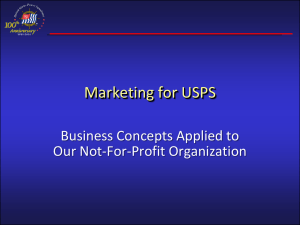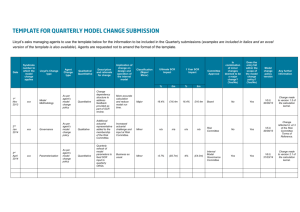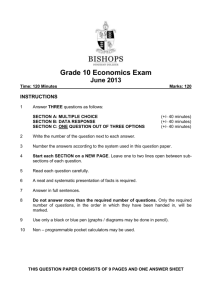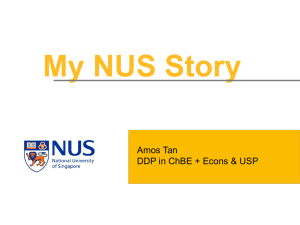Supplementary information for applications to use
advertisement
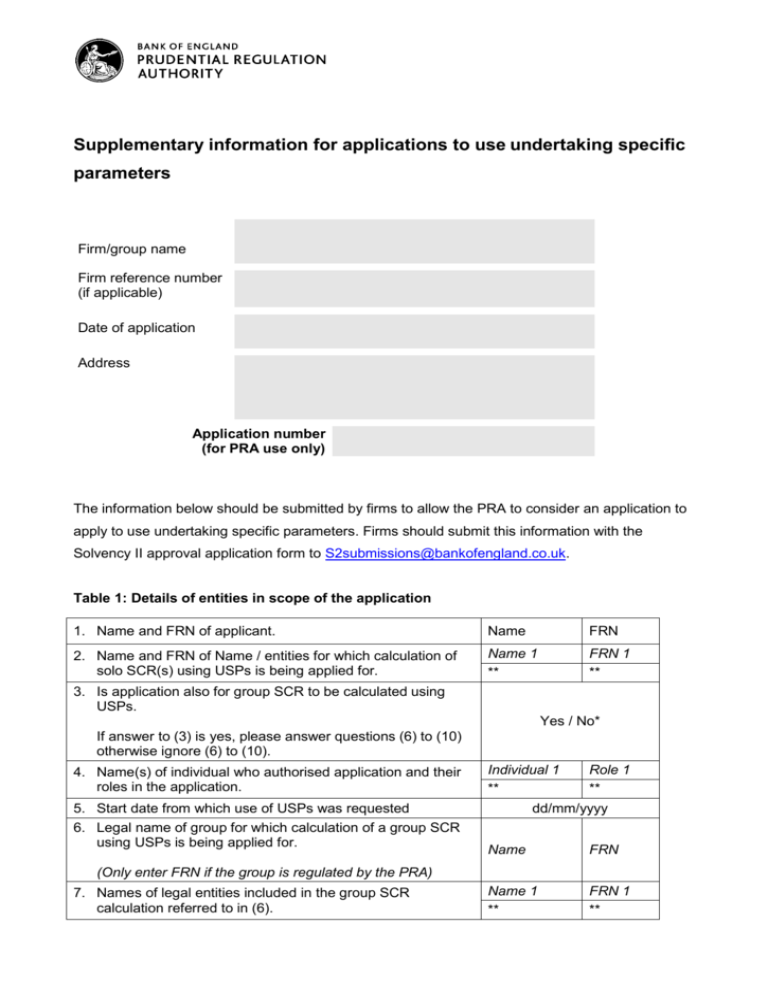
Supplementary information for applications to use undertaking specific parameters Firm/group name Firm reference number (if applicable) Date of application Address Application number (for PRA use only) The information below should be submitted by firms to allow the PRA to consider an application to apply to use undertaking specific parameters. Firms should submit this information with the Solvency II approval application form to S2submissions@bankofengland.co.uk. Table 1: Details of entities in scope of the application 1. Name and FRN of applicant. Name FRN 2. Name and FRN of Name / entities for which calculation of solo SCR(s) using USPs is being applied for. Name 1 ** FRN 1 ** 3. Is application also for group SCR to be calculated using USPs. Yes / No* If answer to (3) is yes, please answer questions (6) to (10) otherwise ignore (6) to (10). 4. Name(s) of individual who authorised application and their roles in the application. 5. Start date from which use of USPs was requested 6. Legal name of group for which calculation of a group SCR using USPs is being applied for. Individual 1 Role 1 ** ** dd/mm/yyyy Name FRN Name 1 ** FRN 1 ** (Only enter FRN if the group is regulated by the PRA) 7. Names of legal entities included in the group SCR calculation referred to in (6). (Only enter FRN if the group is regulated by the PRA) (If the names required in this question are also shown in the answer to question (2), please also state the names in answer to this question) 8. Does the application include a USP for standard deviation for group risk premium risk in the group SCR calculation? 9. Which method is being used to calculate the group SCR referred to (6) above. (Method 1 is the (default) Accounting consolidation-based method in Article 230 of the Solvency II Directive or a combination of method 1 (above) and 2 where method 2 is the (alternative) Deduction and aggregation method in Article 233 of the Solvency II Directive. Please note that under Guideline 11 of EIOPA Guidelines on undertaking-specific parameters, group-specific parameters can only be used with method 1) 10. If the answer to (8) is combination of methods 1 and 2 please provide details. Yes / No* Method 1 / / combination of 1 & 2* (Enter details here, or enter name of documentation containing details, or embed documents containing details. The details should in particular clearly state which of the entities listed under (6) are to be consolidated in the group SCR calculation) Notes: *Please delete as appropriate, ** insert additional rows as required Page 2 of 13 Table 2: Summary of results Premium Risk Entity SF factors USPs Reserve Risk SF factors USPs Life SF factors Heath revision USPs SF factors USPs Total SCR SF factors Own Funds USPs ** Notes: The values for the risk sub modules are pre-diversification risk charges and the SCR is diversified. Table 3: Non-Life Premium and reserve risk sub-module and the NLST health premium and reserve risk sub-module Article 104 (7) of the Solvency II Directive, subset of standard parameters that may be replaced by undertaking-specific parameters Entity (1) Line of Business (LoB) (2) Motor vehicle liability Motor, other classes Marine, aviation, transport (MAT) Fire and other property damage General liability Credit and suretyship Legal expenses Assistance Miscellaneous financial loss Gross / Solo: (S/G) Premium risk σ (3) (4) Undertaking Specific Parameters (USPs) Non-proportional Reserve risk σ reinsurance Method 1 Method 2 adjustment factor (5) (6) (8) Non-proportional reinsurance casualty Non-proportional reinsurance - MAT Non-proportional reinsurance property In table 3 please enter a row for each entity / line of business for which you are applying to use a USP in the SCR calculation. Notes: (1) Entity should be one of the entities listed in table 1 at items (2) or (6). (2) The Line of Business (LoB) is to be one of the lines in parts A to D of Annex I of the Delegated Act. Please state the LoB name and number (LoBs 1 to 12 will be insurance LoBs and LoBs 13-24 will be proportional reinsurance LoBs). (3) Enter S/G to indicate whether USPs in question are for a Group or Solo SCR calculation (4) to (8) Please enter the USP in the box for the USPs you are applying to use for the entity and LoB. If a box for an entity and LoB pertains to a USP you are not applying to use, leave that box blank. (4) to (8) The USP(s) entered in any of the columns (4) to (8) will be calculated from data as at the date(s) specified in table 1 above. (4) to (8) You cannot put an entry in both (4) and (8) –or in more than one of (5) or (6). Table 4: Life sub-module and health revision risk sub-module Entity Life / Health revision risk (1) (2) Gross / Solo: S/G (3) USP (4) ** ** insert additional rows as required Page 4 of 13 In table 4 please enter a row for each entity / line of business for which you are applying to use a USP for the instantaneous permanent increase to be applied to the amount of annuity benefits taken into account in the calculation referred to in articles 141 and 158 of the Delegated Act, provided the annuities are not subject to material inflation risk. Notes: (1) Entity should be one of the entities listed in table 1 at items (2) or (6). (2) Enter ‘life’ or ‘health’. (3) Enter S/G to indicate whether USPs in question are for a Group or Solo SCR calculation. (4) Enter the USP obtained. Page 5 of 13 Table 5: USP appropriateness Please provide answers to these questions and the remaining tables on a separate document keeping the numbering as per the template: USP appropriateness 1. Please explain how your firm’s risk profile for the segments of your USP applications is different from firms represented by the calibration of the Standard Formula and the appropriateness of USPs for the calculation of the SCR with reference to Underlying Assumptions in the standard formula for the Solvency Capital Requirement calculation: https://eiopa.europa.eu/publications/technical-specifications/index.html 2. Please provide rationale of why certain segments (if any) have been excluded from the USP application and discuss the appropriateness of the standard formula for these segments (refer to segments listed in Annex I, of the Delegated Act). Table 6: Governance Area of governance 3. Please provide documentary evidence of sign off for this approval 4. Please provide details of the governance of USPs and in particular, explain the role of your actuarial function in assessing the quality of the data? Include: a. relevant minutes of meetings were USPs were discussed and signed off; b. how you define material changes where you have to report to supervisory authorities; c. the triggers and the procedures that you have established to report to the relevant supervisory authorities; and d. explain how you ensure continuous compliance of the requirements for USPs. 5. Please explain if any reliance is placed on assurance from reviews (internal or external) of the data quality, calculation of USPs, total SCR (SF and/or SF using USPs) or Balance sheet and Technical Provisions. Please include the type of assurance provided and the scope of the Page 6 of 13 review. 6. Please provide details of expert judgement used in the calculation of USPs including evidence of appropriate challenge and governance of the expert judgements applied. 7. Please provide evidence that your data and its production are thoroughly documented as per Article 219 of the Delegated Act. Table 7: Overall Data criteria - Article 219, of the Delegated Act (Article 104 (7) of the Solvency II Directive) The tables that follow aim to establish evidence that data used to calculate the undertaking-specific parameters are accurate, complete and appropriate. Data accuracy 8. Please provide your definition of material error and how you ensure your data is free from it. 9. Please explain significant process changes that could affect accurate recording of the data used to calculate the USPs. Data completeness 10. Please provide evidence that you have sufficient historical and granular information to allow for the measurement of volatility and uncertainty for each USP and LoB. Include a table which sets out the number of years of premium, exposure and claim data used for each USP and LoB and a rationale for excluding any data point(s) in the calculation(s) if you have done so. 11. Please provide a summary of the comparison between the use of the data for the USP calculation and Technical Provisions (TP) calculation and explain any differences. This should include differences in the accident years used. Data appropriateness 12. Please explain how the data used for USPs is consistent with the assumptions underlying the actuarial and statistical techniques that are Page 7 of 13 applied to them. 13. Please explain what data adjustments have been made for each LoB and USP? Include details on the validation carried out to ensure the data after adjustments meet the requirements of Article 219 of the Delegated Act. 14. Please set out any adjustments made to historic data to ensure it is relevant over the next 12 months. 15. Please set out the process and frequency of regular updates of the data used including the triggers for additional updates. 16. Please identify any factors that adversely affect the quality of the data and possible solutions. External Data (complete only if you have used external data as defined by the Solvency II Directive) 17. Please explain why the external data is more suitable than internally sourced data for the calculation. 18. Please explain the source(s) of the external data and the methodology and assumptions used to process this data. 19. Please identify any trend(s) or variation of the assumptions and methodologies used to process the data over time. 20. Please explain process of the data collection and how the methodology and assumptions used to process the external data reflect your risk profile. Table 8: Premium risk data - Annex USP II premium risk method Data for Premium risk method 21. Please explain how the data are representative for the insurance risk exposed to during the following 12 months. 22. Please confirm the accident years to which the data are related to. 23. Which of the standard parameters do you intend to replace: non-life premium risk OR non-life gross premium risk. 24. , Please set out details of the reinsurance contract(s) and SPV arrangements in the following 12 months and explain whether your earned premiums and aggregated losses have been adjusted for recoveries from reinsurance or Special Purpose Vehicles (SPVs) or reinsurance Page 8 of 13 premiums. If the answer is yes, please include an explanation of how the adjustments for recoveries and premiums are consistent with the arrangements that are in place for the following 12 months. 25. Please explain how the aggregated losses are adjusted for catastrophe claims to the extent that the risk of those claims is reflected in the non- life or health catastrophe risk sub-modules 26. Please confirm whether you have included expenses incurred in servicing the insurance and reinsurance obligations in the aggregated loss data and specify the expenses and their quanta. Please confirm how you have allocated fixed expenses to this particular segment. 27. Please provide evidence that your aggregated losses are linearly proportional to earned premiums in a particular accident year and the variance of aggregated losses are quadratic in premiums earned in a particular accident year for each segment. 28. Please provide evidence to show that aggregated losses follow a lognormal distribution include relevant charts and diagnostics comparing your observed data and the fitted lognormal distribution. 29. Please provide evidence how maximum likelihood estimation is appropriate for this data. Page 9 of 13 Table 9: Reserve Risk Data for reserve risk 30. Please explain how the data are representative for the reserve risk that the undertaking is exposed to during the following 12 months. 31. Please specify which accident years the data relate to for method 1 and 2. 32. Please explain how data used to calculate the USPs for reserve risk reflect the reinsurance coverage and the basis of operation of the reinsurance programme. 33. Please explain how the data for method 1 and cumulative claims amounts in method 2 are adjusted for the amounts recoverable from the reinsurance contracts or SPVs which are in place to provide cover for the following twelve months. 34. Please explain if there have been any significant changes in your reserving philosophy over the period of time to which the data is related. 35. Please explain how you have included expenses in the aggregated loss data specifying the expenses and their quantum. Please include in the explanation how you have allocated fixed expenses for each particular segment. 36. Please compare and contrast the two methods specified in Annex XVII C. and D. of the Delegated Act for the reserving risk USP calculation and explain why your chosen reserving method produces the most accurate result to fulfil the calibration requirements included in Article 101 (3) of the Solvency II Directive. Page 10 of 13 Table 10: Reserve Risk – Method 1 data - Annex XVII (C) Reserve risk method 1 of the Delegated Act Data for reserve risk method 1 37. Please provide evidence that the claims incurred1 have a linear relationship with the best estimate of the provision for claims outstanding for each segment. 38. Please provide evidence that claims incurred are quadratic in premiums earned in a particular accident year for each segment. 39. Please provide evidence that claims incurred follow a lognormal distribution - provide relevant charts and diagnostics comparing your observed data and the fitted lognormal distribution. 40. Please provide evidence to show maximum likelihood estimation is appropriate for this data. Table 11: Reserve Risk – Method 2 data- Annex XVII (D) Reserve risk method 2 of the Delegated Act Data for reserve risk method 2 41. Please confirm that data are available for at least five consecutive accident years and in the first accident year, data are available for at least five consecutive development years. 42. Please provide evidence to show that in the first accident year the cumulative payment amounts of the last development year for which data are available includes all the payments of the accident year except an immaterial amount. 43. Please explain how the data are consistent with the assumptions about the stochastic nature of cumulative claims amounts as set out in D. Reserve risk method 2 (2)(h). 1 sum of the best estimate provision for claims outstanding at the end of the financial year and the claims paid at the during the financial year Page 11 of 13 Table 12: Non-proportional reinsurance method data Data for non-proportional reinsurance method 44. For each segment where excess of loss reinsurance is used, please explain how it meets the conditions set out in Article 218(2) of the Delegated Act. 45. Please explain any planned changes envisaged in the business mix and reinsurance contract in the following 12 months compared to that represented in the data used for calculations. 46. Please compare and contrast the standard deviation for premium risk implied from the claim data used here with the standard deviation used to calculate the premium risk charge for the SCR. 47. Please provide evidence to show your ultimate claim cost was estimated on the year when the claim was reported, i.e. your initial estimation of the claim cost. 48. Please list the reporting years to which the data is related to. 49. Please confirm whether your ultimate claim amounts include expenses incurred in servicing the insurance and reinsurance obligations. 50. Please provide evidence that the ultimate claim amounts follow a lognormal distribution and provide charts comparing your observed data and the fitted lognormal distribution. 51. Please explain how the data, both gross and net of proportional reinsurance, for the next 12 months, complies with data criteria set out in Guidelines 1 to 7 in the EIOPA Guidelines on undertaking-specific parameters. Page 12 of 13 Table 13: Life and Health Revision risk data Life and Health revision risk data 52. Please explain how the data are representative for the revision risk exposed to during the following twelve months. 53. Please confirm that the annuity benefits are gross, without deduction of the amounts recoverable from reinsurance contracts and SPVs and that the annuity benefits include the expenses incurred in servicing the annuity obligations. 54. Please provide relevant charts and diagnostics which demonstrate that the annual number of annuity increases follows a negative binomial distribution, including in the tail of the distribution. 55. Please provide relevant charts and diagnostics which demonstrate that the amount of an annuity increase follows a lognormal distribution, including in the tail of the distribution. 56. Please explain how the annual number of annuity increases and the amounts of the annuity increase are mutually stochastically independent. 57. Please explain how sufficient data is available to allow measurement of the volatility and uncertainty of the behaviour of biometric factors and impact of the legal environment on potential revisions to annuities. Table 14: Group Specific Parameters Group Specific Parameters 58. Please provide a comparison of the reinsurance and SPVs at group and solo level. 59. Please explain how the nature of the group business and its risk profile are similar enough to those of the solo undertakings. Please provide statistical evidence that the data at solo and group level exhibit a high degree of similarity. March 2015 Page 13 of 13
